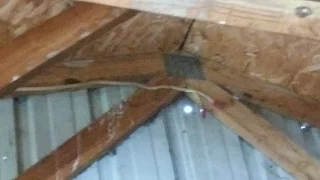 |
| Rat's nest is both figuratively and literally true. |
I have been looking at the wiring in the barn closest to Sprite's house and it is starting to make sense.
The first generation of lighting was incandescent bulbs on 12 gauge wire.
The second generation of lighting was Metal Halide on even heavier wire.
The third generation was big, LED corn-cobs screwed into half of the incandescent fixtures.
 |
| A wire in the peak of the building that has been capped off. There is a reasonable chance this wire is hot and it is my second choice for powering-up the run of wire I will be using. |
 |
| Room for two more breakers but I don't want to screw around with that |
The scrapped run of wire already goes to a flood-light on the exterior of the building. I will replace that flood light with a motion activated light with two, 9 Watt BR-30 bulbs in 6500K. Then I will daisy-chain a second motion activated fixture just around the corner to light that side of the building.
I will be living in sin because the outdoor cable I have is 14 gauge and it will be fed by a 20 Amp breaker in the box. 14 gauge copper is rated for 15 Amps/1500 Watts.
 |
| Second motion activated light will be on the shady side of the barn |
*There are exceptions in the National Electrical Code that recognizes a class of wiring sometimes called "chassis wiring". That means that the electrician must run heavy wire to the electrical dryer but internal to the dryer the manufacturer can use lighter gauge wiring. The rational is that runs less than 12' do not cause appreciable voltage sag AND because copper wire rejects heat out the ends as well as by convection to air. Short segments can avoid overheating failures if they have more generous wire gauge

What is pictured? Is that the feed into the panel or a dryer plug? I'd check for aluminum wire. Just the sort of thing that could be had cheap for use in a barn. And of course, you know about anti-oxident.
ReplyDeleteThe infrared image was pulled off the internet.
DeleteThe first image is from beside the door and includes two metal receptacles, an outlet and three runs of wire, all abandoned.
The IR image was making me panic for you.
ReplyDeleteRead the tap rules, you may have an exception for that short, 14ga run to the outside light. Or, just put a 15A breaker on that circuit. Or, put a 15A fuse in the circuit upstream of the 14ga cable.
ReplyDeleteFor the lights fed through the outlet, remove the outlet and make it a junction box.
Thanks. Good idea.
DeleteThat's a double-ditto on that aluminum wiring. I've had to re-lay a buried main line to a barn over just precisely that issue, vintage 70's stuff.
ReplyDelete